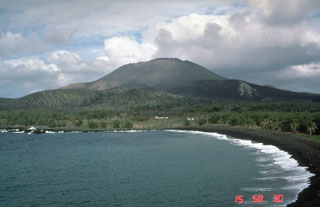Report on Pagan (United States) — August 1988
Scientific Event Alert Network Bulletin, vol. 13, no. 8 (August 1988)
Managing Editor: Lindsay McClelland.
Pagan (United States) Ash cloud
Please cite this report as:
Global Volcanism Program, 1988. Report on Pagan (United States) (McClelland, L., ed.). Scientific Event Alert Network Bulletin, 13:8. Smithsonian Institution. https://doi.org/10.5479/si.GVP.SEAN198808-284170
Pagan
United States
18.13°N, 145.8°E; summit elev. 570 m
All times are local (unless otherwise noted)
A warning to aircraft (SIGMET) issued early 26 August reports that an ash cloud from Pagan was observed near 18.2°N, 145.8°E on 25 August at 1015. The ash cloud extended 110 km NW. Its height was unknown but was believed to be less than 3 km. No other reports of activity were received.
Geological Summary. Pagan Island, the largest and one of the most active of the Mariana Islands volcanoes, consists of two stratovolcanoes connected by a narrow isthmus. Both North and South Pagan stratovolcanoes were constructed within calderas, 7 and 4 km in diameter, respectively. North Pagan at the NE end of the island rises above the flat floor of the northern caldera, which may have formed less than 1,000 years ago. South Pagan is a stratovolcano with an elongated summit containing four distinct craters. Almost all of the recorded eruptions, which date back to the 17th century, have originated from North Pagan. The largest eruption during historical time took place in 1981 and prompted the evacuation of the sparsely populated island.
Information Contacts: D. Subera, US Dept of Interior; N. Banks, CVO.

